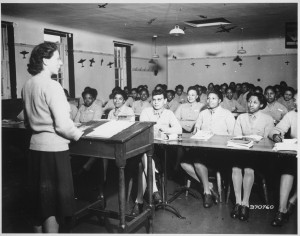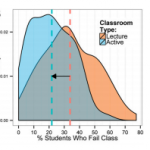“Enough with the Lecturing” is the title of a May 12, 2014 press release from the National Science Foundation (NSF) which summarizes the results of a meta-analysis study testing the hypothesis that lecturing maximizes learning and course performance in the STEM (science, technology, engineering and mathematics) classroom.  The study was conducted by members of the Department of Biology at the University of Washington and School of Biology and Ecology at the University of Maine. A paper describing it entitled “Active learning increases student performance in science, engineering and mathematics” appears in the May 12 Early Edition of Proceedings of the National Academy of Sciences.
The study was conducted by members of the Department of Biology at the University of Washington and School of Biology and Ecology at the University of Maine. A paper describing it entitled “Active learning increases student performance in science, engineering and mathematics” appears in the May 12 Early Edition of Proceedings of the National Academy of Sciences.
So what is the problem to be solved? In 2012 the PCAST (President’s Council of Advisors on Science and Technology) STEM Undergraduate Working Group reported that less than 40% of U.S. students who enter universities with an interest in STEM programs earn a STEM degree. This percentage drops to 20% for underrepresented minority students…not a pretty picture…
In their report, PCAST called for a 33% increase in the number of STEM bachelor’s degrees completed annually, and one of their recommendations to reach this goal was the adoption of empirically validated teaching practices in the first two years of the STEM undergraduate curriculum. The report goes on to state: “Classroom approaches that engage students in “active learning” improve retention of information and critical thinking skills, compared with a sole reliance on lecturing, and increase persistence of students in STEM majors.”
Those of us in academia have titles such as lecturer or professor (one who professes!) These titles are in keeping with the traditional mode of instruction in universities which has utilized an instructor-focused “teaching by telling” philosophy. In contrast, in an active learning environment, teachers facilitate the process of students constructing their own understanding often through asking questions. The main question Freeman et al. asks in this study is: “In the STEM classroom, should we ask or should we tell?”
The project involved the meta-analysis of the data from 225 published and unpublished studies which documented student performance in courses employing some active learning versus the traditional lecture methodology. Meta-analysis is a technique commonly used in fields such as medicine for determining the effectiveness of a particular treatment based on studies with a variety of patient groups, providers and methods of administering the therapy or drugs. Freeman et.al.’s analysis focused on two questions: (1) does active learning boost exam scores and (2) does active learning lower failure rates?
The study found that students in active learning environments showed an average increase in exam and other assessment scores of 6%. What was even more interesting to me was the difference in failure rate between the two teaching approaches. While no method can save every student, the authors found a 21.8% failure rate in the active learning classroom versus 33.8% with the traditional lecture approach.  In other words, students were found to be 1.5 times more likely to fail in the lecture style classroom. The study indicated that students in all sizes of classes benefitted from active learning. There also were no significant differences in the effect of active learning between courses for STEM majors and nonmajors.
In other words, students were found to be 1.5 times more likely to fail in the lecture style classroom. The study indicated that students in all sizes of classes benefitted from active learning. There also were no significant differences in the effect of active learning between courses for STEM majors and nonmajors.
The authors conclude: “Although traditional lecturing has dominated undergraduate instruction for most of a millenium and continues to have strong advocates, current evidence suggests that a constructivist ‘ask, don’t tell’ approach may lead to strong increases in student performance — amplifying recent calls from policy makers and researchers to support faculty who are transforming their undergraduate STEM courses.”
I have been using a flipped classroom instructional approach in my organic chemistry course. My students watch short video presentations outside of class (typically 15-25 minutes in length) on the topics that will be covered in the next class. In the classroom, questions concerning the material are presented which the students answer using student response devices (clickers). Most of the questions require the students to work out the answers by figuring out how the electrons flow; work through multistep syntheses; or apply what they know to systems different than what they have previously seen. It does sometimes get a little loud as students debate and help each other come up with answers. After everyone has selected an answer, we work our way as a group through the thought processes needed to arrive at the correct answer. Although I do not have enough data to make any statistically valid conclusions, I have seen an improved retention across the three terms of the course since moving to the flipped classroom. So far I can’t say that I am seeing more students earning A’s, but I have seen decreased numbers of D’s, F’s and dropouts. Only time will tell if this trend is a permanent one.
Writing this post brought back memories of an all-but-forgotten educational experience I had many years ago. As a new graduate student at Texas A&M University in 1975, I was offered the opportunity to increase my TA stipend by $25 a month (which then was a significant amount!) if I took a course offered by Dr. Glenn R. Johnson of the then Department of Educational Curriculum and Development. Of course I, and a number of other Chemistry grad students, jumped at the opportunity. The Chemistry Department was hoping to make us better at our teaching duties, but we just wanted to eat better! Dr. Johnson’s philosophy was that a significant amount of instruction in the classroom should be in the form of questioning. As part of the course, we had to teach a number of short, videotaped lessons in our field of expertise using different types of questions. Of course, we all jumped through the hoops to get through the class, but I doubt if any of us took the educational philosophy seriously. After all, all of our role models had taught us using the lecture tradition, and we hadn’t turned out so badly had we? I actually got an A in the class, received my $25/month increase, earned a Ph.D. and have spent 32 years as a professor. It is amazing that while I had all but forgotten about that experience, I am doing exactly what Dr. Johnson tried to get us to do…teach by asking questions!
